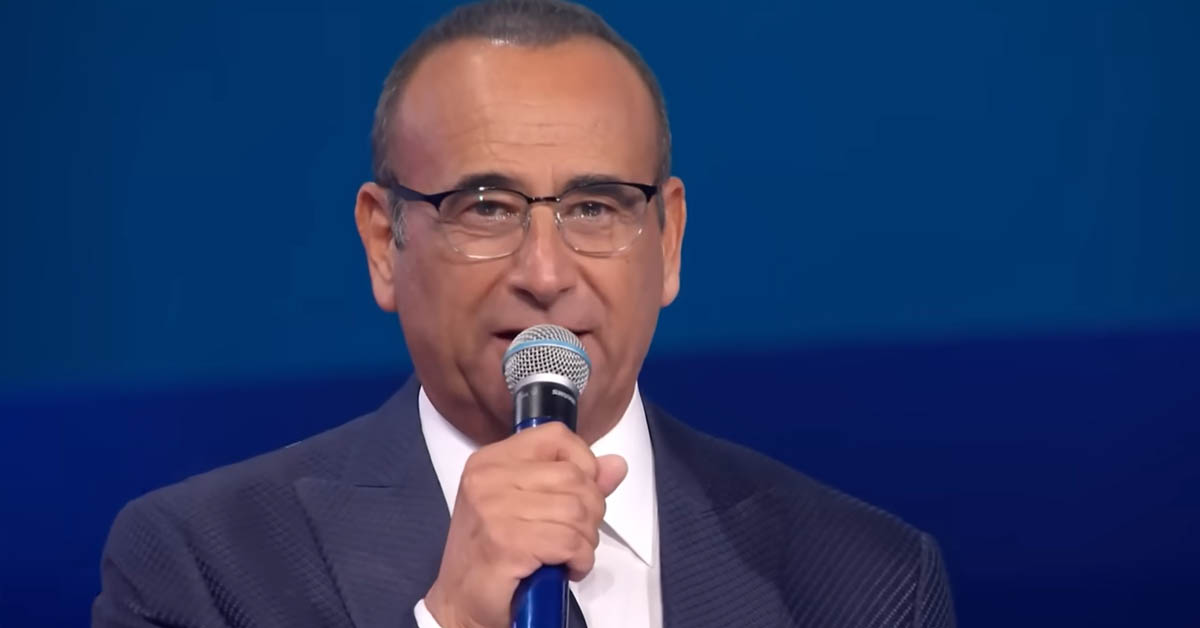
End of an era: Carlo Conti, the man who became a symbol of Featival Di Sanremo, ends his journey after more than 40 years with RAI and five unforgettable editions as host and artistic director.
Featival Di Sanremo 2026 will mark a historic moment not only for Italian music but also as a farewell to one of its defining figures. Carlo Conti, the cheerful yet meticulous television personality who led the iconic event over five editions, has announced that the upcoming festival will be his last as both host and artistic director. For many in Italy – and Eurovision fans in Israel – this truly signals the end of an era.
Featival Di Sanremo is widely regarded as one of Italy’s most respected and influential music events, held annually in the coastal city of Sanremo in northern Italy. Beyond its role as a national cultural celebration, the festival has a deep historical connection – it inspired the very creation of the Eurovision Song Contest. In practice, Sanremo also serves as Italy’s Eurovision national selection: the festival’s winner receives the first opportunity to represent Italy at Eurovision. If the winner declines, the national broadcaster RAI selects another participant from among the festival’s contestants.
Carlo Conti Says Goodbye
 Four decades on Italy’s public television have made Carlo Conti nothing short of a national institution.
Four decades on Italy’s public television have made Carlo Conti nothing short of a national institution.
“Five festivals are a great achievement – it’s enough”.
Conti told Corriere della Sera in an interview marking his 40-year career with RAI. His words, spoken with typical Italian humility, carried the weight of years spent steering one of television’s most demanding productions.
“Artistic direction is the biggest commitment. Hosting is just the tip of the iceberg”.
Conti admitted – an almost confessional remark from a man who guided the festival through cultural, musical, and even political storms.
64 year-old Conti has led Sanremo through both the 2015–2017 editions and the modern 2025–2026 revival. His tenure successfully bridged classic Italian television charm with modern entertainment, uniting veteran performers unafraid to return to the grand stage with younger songwriters and artists born in the post-Eurovision generation.
Who Will Step Into Conti’s Shoes?
 When asked who might fill his sizeable shoes, Conti mentioned one name without hesitation: Stefano De Martino.
When asked who might fill his sizeable shoes, Conti mentioned one name without hesitation: Stefano De Martino.
“He has all the right cards to succeed – dance gave him discipline and rules”.
Conti said.
35 year-old Stefano De Martino first gained fame as a dancer before becoming one of the leading figures of Italy’s new generation of TV hosts. He has presented popular shows including Made in Sud, Tonight Everything Is Possible, and Bar Stella, and also served as a judge on Amici di Maria De Filippi. In 2024 he was chosen to host Affari Tuoi, a role that cemented his reputation for warmth, charm, and ease on screen.
Today, De Martino is considered one of RAI’s most sought-after television personalities – a natural candidate to bring younger audiences back to the festival while maintaining national pride in one of Italy’s most enduring cultural symbols.
Festival Di Sanremo 2026: What Should We Expect?
Despite the emotions surrounding his farewell, Conti is far from resting. He has already started listening to proposed songs for the upcoming festival – from rising talents to established stars – since the submission period remains open.
As always, preparations mean long days and sleepless nights. This year, unlike 2025, the festival will feature the traditional 26 songs, even though the rules permit up to 30.
“This time I have to be strict, even ruthless, to cut four songs. The choice keeps me awake!”
He shared with a smile and a candid look that reflected his love for the craft.
On December 14th, the official list of competing songs will be revealed.
Sanremo Giovani
Ahead of the main festival, the Sanremo Giovani contest will take place – a qualifying competition for young performers aged 16–29. This event culminates on December 14th with a grand final where four contestants are chosen to advance to the main festival in February, performing alongside Italy’s established artists. Although they participate separately from the veteran acts, these young performers get a valuable platform. The category’s winner earns the title of “New Discovery of the Year”, though cannot represent Italy at Eurovision.
A Historic First: Public Tender for the Festival
Following a ruling by Italy’s Supreme Court mandating a public tender for producing the festival, the long-standing exclusive arrangement under which RAI handled production is set to change. For the first time, other production companies will be able to bid to organize the festival, though RAI – the national broadcaster – will remain responsible for broadcasting it.
According to RAI’s agreement with the city of Sanremo, the festival will continue to take place in the city at least through 2028, and RAI will keep broadcasting the event to millions of viewers in Italy and abroad, even if it isn’t the sole producer.
Dates and Format of Festival Di Sanremo 2026
Like every year, the festival will span five nights, structured as follows:
-
First Night (Tuesday, February 24th, 2026):
24 artists will perform their competing songs. A jury composed of professional journalists from television and online media will vote. RAI will then announce, in random order, the top five entries receiving the highest scores. -
Second Night (Wednesday, February 25th, 2026):
12 artists will perform. Voting will be split between the public (50%) and a radio jury (50%). The top five will be announced randomly. -
Third Night (Thursday, February 26th, 2026):
The remaining 12 artists will perform. Voting will again be divided between the public (50%) and the radio jury (50%). The top five will be announced randomly. -
Fourth Night (Friday, February 27th, 2026):
Contestants will perform cover versions of existing songs in Italian, English, or other languages. They may collaborate with guest performers. Voting will be divided between the public (34%), a professional jury of journalists (33%), and a radio jury (33%). Results from this night will not count toward the overall competition. -
Fifth Night (Saturday, February 28th, 2026):
All 24 artists will perform again with their competing songs. The public vote will be added to the cumulative scores from previous nights to determine the five superfinalists. These five will then perform again, with the winner chosen based on votes from the public (34%), the journalists’ jury (33%) and the radio jury (33%). The performance with the highest score will be declared the winner of Sanremo 2026.
In addition to the main competition, the festival will feature the “Nuove Proposte” category for young artists. On the second and third nights, four emerging performers will showcase their songs. One artist from each night will advance to the final, where, on the fourth night, the winner will be chosen through a mixed vote of the public (34%), journalists (33%), and the radio jury (33%).
Italy at Eurovision 2025
“Volevo essere un duro” (in English: “I Wanted to Be Tough”) is the song performed by singer Lucio Corsi, which came second at the 75th edition of the Sanremo Festival. The song was written by the singer himself along with Tommaso Ottomano. This was the singer’s first-ever appearance at the festival. The song is performed in Italian. The song finished fifth in the grand final with 256 points.
Italy returns to the Eurovision Grand Final Top 5 after last year achieving “only” seventh place.
Eurovision 2026: This will be Italy’s 51st participation in Eurovision. Italy joined the contest in 1956, was one of the seven founding countries, and has won three times over the years. Italy’s most recent victory was at Eurovision 2021 with the song “Zitti e buoni” performed by the band Måneskin.

Email: [email protected]
Phone: +972-50-9441919
Ilay Gaist is a leading Israeli content creator and writer specializing in the Eurovision Song Contest. He is a well-known commentator with extensive expertise in the contest’s history, rules, and dynamics. His passion for Eurovision drives him to deliver rich, professional, and innovative content to his audience.
Ilay holds a bachelor’s degree in Arabic and has a multilingual background. He also engages in cultural research, with a particular focus on global culinary traditions and the evolution of local cuisines around the world.








